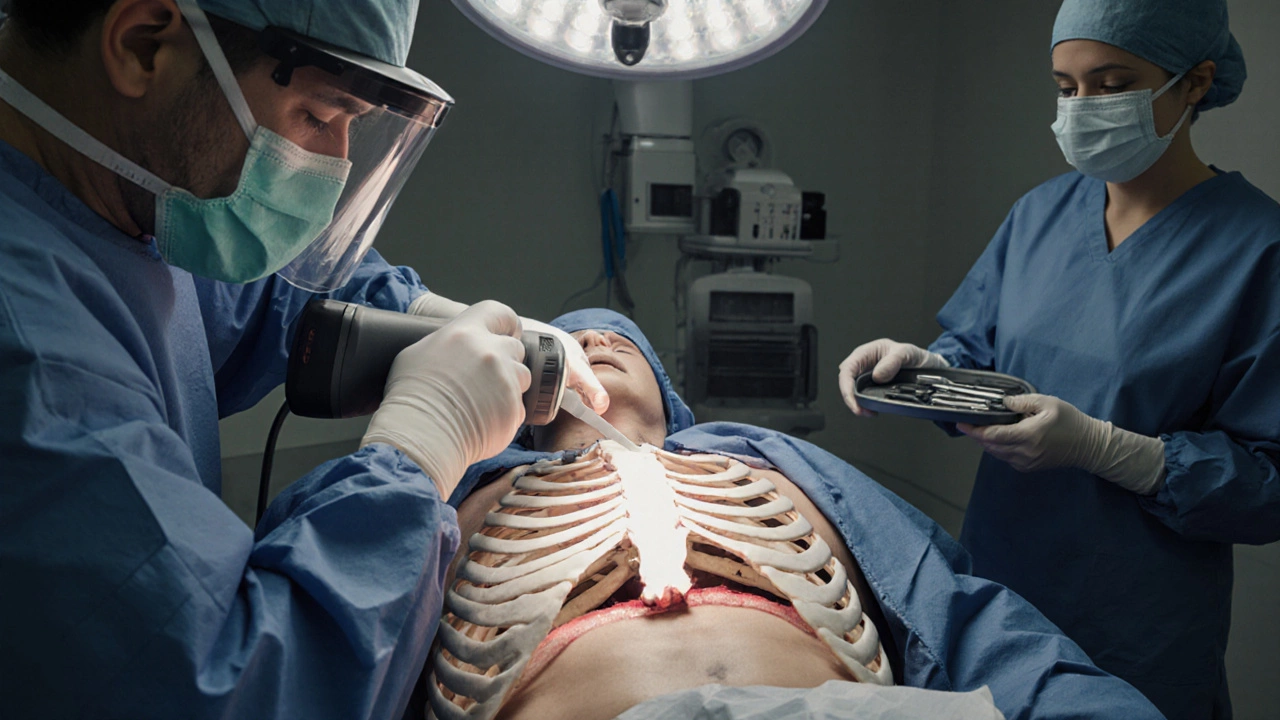Open-Heart Surgery Approach Advisor
How to choose your approach
Select your top priority to see which surgical technique best matches your needs. Based on your choice, we'll show the optimal access method for open-heart surgery.
Select Your Priority
Recommended Approach
Choose your priority above to see your recommended surgical approach
How this works
This tool uses your priorities to match your situation with the most appropriate surgical approach based on the article's facts:
- ✓ Stemotomy: Standard approach with maximum exposure (15-20cm scar)
- ✓ Minimally Invasive: Smaller incision (5-8cm), less pain
- ✓ Robotic: Tiny ports (1-2cm), minimal trauma
Ever heard someone say a surgeon has to "break your ribs" to reach the heart? It sounds dramatic, but is there any truth to it? Let’s separate fact from fiction and walk through how surgeons actually open the chest, the modern alternatives, and what you can expect if you face an open‑heart procedure.
What is Open heart surgery is a type of cardiac operation that requires direct access to the heart muscle and chambers. Doctors pause the heart’s normal pumping using a heart‑lung machine (cardiopulmonary bypass) so they can repair or replace damaged tissue.
The need for a clear view means the chest cavity must be opened, but the way we do that has evolved dramatically over the past century.
Traditional Access: Sternotomy and Rib Spreading
The classic method is called a sternotomy. A midline incision is made over the breastbone (sternum), and the bone is split with a specialized saw. This creates a ‘gate’ that swings open, giving the surgeon a direct line to the heart. The ribs themselves stay intact; the sternum is the only bone that’s divided.
Some older textbooks mention rib spreading. In procedures that use a lateral thoracotomy (an incision between the ribs), the ribs are gently retracted rather than broken. The force is controlled, and the bones heal without permanent damage. For most open‑heart cases, especially valve replacements or coronary artery bypass grafting (CABG), surgeons prefer sternotomy because it offers the widest exposure and avoids rib trauma.
Why the “broken ribs” Myth Persists
Confusion often stems from mixing up different chest‑opening techniques. Thoracotomies, common in lung surgery or certain pediatric cardiac repairs, do involve spreading the ribs. Media stories about "rib‑splitting" for heart surgery may actually be referencing those cases.
Another contributor is the visual of a surgeon wielding a large saw. To the untrained eye, splitting a bone looks like a break. Add a few dramatic headlines and the myth spreads.

Modern Alternatives: Less Invasive Paths to the Heart
Advances in imaging, instrumentation, and robotics have given patients options that spare the sternum and reduce postoperative pain.
| Technique | Bone Involved | Incision Length | Typical Recovery (days) | Key Benefits |
|---|---|---|---|---|
| Sternotomy | Sternum split | 15-20 cm | 7‑10 | Maximum exposure, versatile |
| Minimally invasive cardiac surgery (MICS) | Small rib retraction (optional) | 5-8 cm | 4‑6 | Smaller scar, less pain |
| Robotic‑assisted heart surgery | None (thoracoscopic ports) | 1‑2 cm ports | 3‑5 | Precision, minimal trauma |
In minimally invasive cardiac surgery, surgeons make a small incision between the ribs and use a thoracoscopic camera plus specialized instruments. The ribs are gently spread, not broken, and the incision heals quickly.
Robotic‑assisted heart surgery takes it a step further. A surgeon sits at a console, guiding robotic arms that hold the camera and tools. Four tiny ports (about a centimeter each) are all that’s needed, meaning no bone is cut at all.
Risks, Pain, and Recovery: How They Differ
All cardiac surgeries carry inherent risks-bleeding, infection, arrhythmia, and complications from the heart‑lung machine. The choice of access method influences secondary factors:
- Sternotomy: Greater postoperative pain due to bone healing, higher chance of sternal infection, but reliable exposure for complex repairs.
- Minimally invasive: Less pain, shorter ICU stay, but requires specialized expertise and may limit the surgeon’s view for very large defects.
- Robotic‑assisted: Minimal pain and scar, quicker return to daily activities, yet the equipment cost can increase overall hospital charges.
None of these approaches “break” ribs in the permanent sense. Surgeons may apply temporary force to separate ribs, but the bone tissue recovers fully within weeks.

What to Expect During the Pre‑Op Journey
If you’re scheduled for open‑heart surgery, your team will walk you through these steps:
- Pre‑operative imaging: A CT scan or MRI maps the chest anatomy, showing whether a sternotomy or a less invasive route suits you.
- Discussion of access method: Your surgeon explains which technique will be used and why. Ask specifically about rib involvement.
- Preparation for cardiopulmonary bypass: Blood thinners are stopped, and a central line is placed for the heart‑lung machine.
- Operation day: Anesthesia, incision (or ports), and the chosen access method are performed. The heart is stopped temporarily while repairs are made.
- Recovery: ICU stay of 1‑2 days, followed by a step‑down unit. Pain management plans differ-sternal stitches may need more analgesics compared to port sites.
Ask for a copy of the surgical plan. Knowing whether the sternum will be split or if the team is using a robotic system helps you set realistic expectations and eases anxiety.
Quick Checklist: Questions to Ask Your Surgeon
- Will the sternum be split, or are we using a minimally invasive approach?
- If ribs need to be spread, how is the force controlled and what’s the expected healing time?
- What are the pain‑control options specific to the chosen access method?
- How does the approach affect the overall surgery duration and hospital stay?
- Are there any extra costs for robotic assistance, and is it covered by insurance?
Having clear answers lets you focus on recovery rather than worry about a myth.
Do surgeons actually break any ribs during open‑heart surgery?
No. In a standard sternotomy the breastbone is split, not the ribs. When a lateral thoracotomy or minimally invasive approach is used, the ribs may be gently retracted, but they are not broken.
What is the difference between a sternotomy and a thoracotomy?
A sternotomy divides the central breastbone to open the chest. A thoracotomy makes an incision between the ribs on the side of the chest and often requires rib spreading.
Are minimally invasive heart surgeries as safe as traditional sternotomy?
For many valve repairs and coronary bypasses, minimally invasive techniques have shown comparable safety with less pain and quicker recovery. Complex multi‑vessel procedures may still need a full sternotomy.
Will my scar be larger if the sternum is split?
Yes, a sternotomy typically leaves a 15‑20 cm vertical scar down the middle of the chest. Minimally invasive or robotic ports usually leave very small, often hidden scars.
How long does it take for the sternum to heal?
Bone healing generally takes 6‑8 weeks. Patients are advised to avoid heavy lifting and to follow sternal precaution guidelines during this period.
